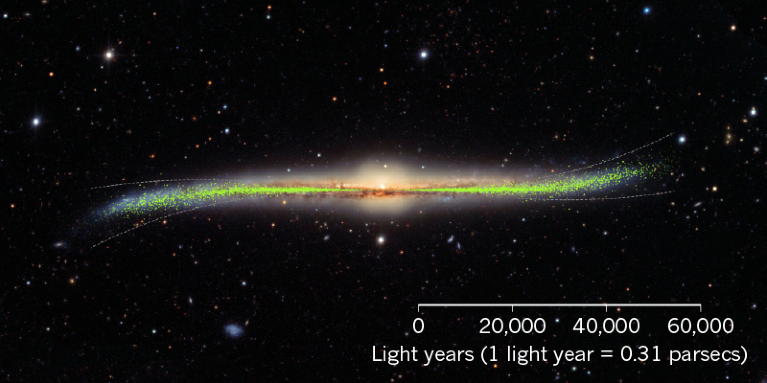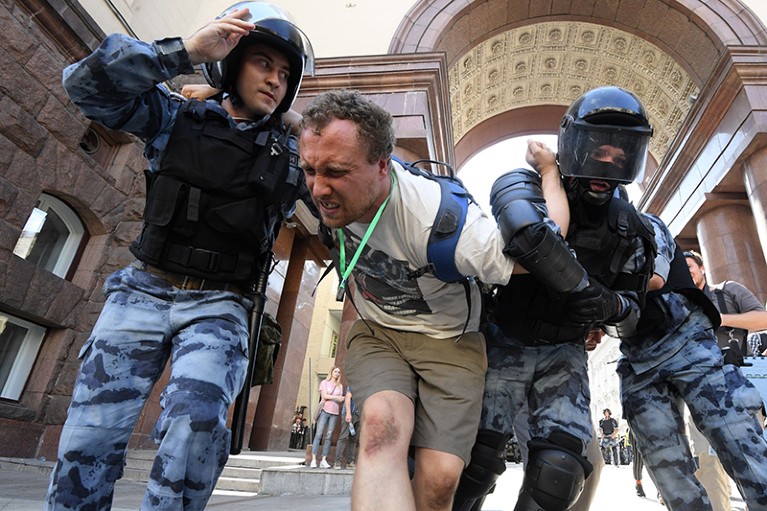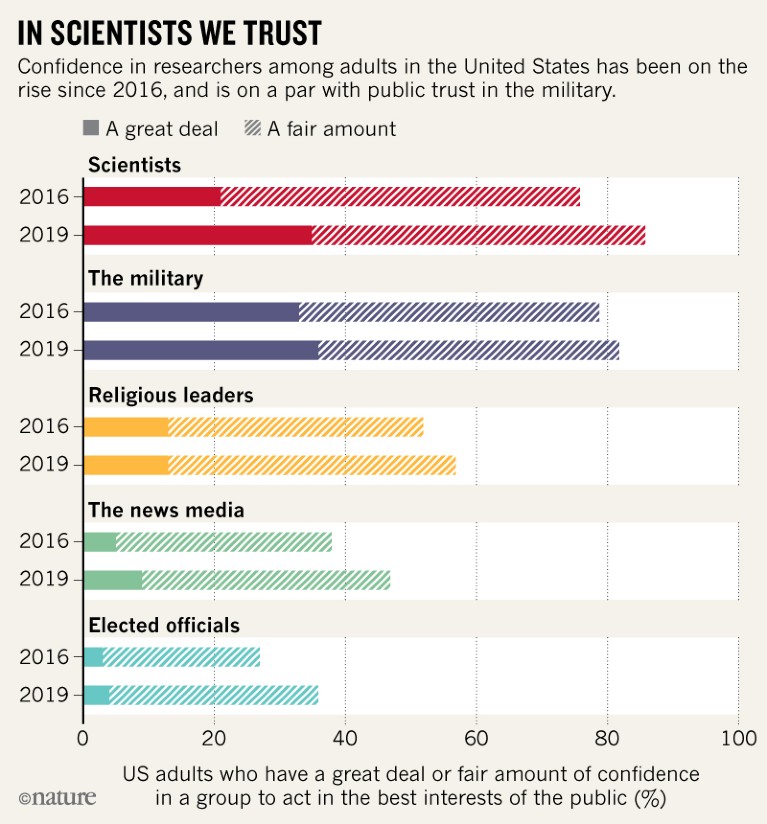SPACE
Map shows Milky Way’s warped disk The twisted form of the Milky Way has been revealed in 3D, thanks to a map of bright, young pulsating stars. Researchers at the University of Warsaw measured the positions of 2,431 supergiant stars known as Cepheids using the Optical Gravitational Lensing Experiment telescope at Las Campanas Observatory in Chile. The team timed how quickly each of the stars pulses in size and temperature. The slower a star pulses, the brighter it is, a relationship that can be used to calculate a star’s true brightness. This can be compared against their apparent brightness levels, as measured from Earth, to reveal their distance. Plotting the distances in 3D produces a trace of the Galaxy’s spiral arms, and shows how the disk warps at its farthest reaches, forming an S-shape when seen side-on. The chart is the most detailed yet to be made of the Galaxy using only direct distances to individual stars (D. M. Skowron et al. Science 365, 478–482; 2019).

A map of more than 2,400 supergiant stars reveals how the Milky Way forms an S-shape when seen side-on.Credit: J. Skowron/OGLE
POLICY
Missile treaty The United States formally withdrew from the Intermediate-Range Nuclear Forces (INF) Treaty on 2 August. Signed by former US president Ronald Reagan and Soviet Union leader Mikhail Gorbachev in 1987, the treaty bans missiles with ranges of 500–5,500 kilometres. Under the agreement, the United States destroyed 846 missiles and the Soviet Union eliminated 1,846. But on 1 February, US President Donald Trump announced that the country would withdraw from the treaty, citing non-compliance by Russia and a lack of participation by other countries, such as China. Russian President Vladimir Putin followed suit on 2 February. The remaining treaty that limits the number of nuclear weapons held by the two countries — the New Strategic Arms Reduction Treaty (New START), signed in 2010 — is set to expire in February 2021 and seems unlikely to be renewed.
CLIMATE
Sun project panel Plans to test a technique to cool the planet by blocking sunlight are one step closer to reality. Harvard University in Cambridge, Massachusetts, has created an eight-member external advisory panel to examine potential ethical, environmental and geopolitical impacts of the geoengineering project, developed by researchers at the university. The Stratospheric Controlled Perturbation Experiment (SCoPEx) will involve the release of calcium carbonate particles from a steerable balloon some 20 kilometres above the southwestern United States. Project researchers will study how the particles disperse and watch for changes in atmospheric chemistry and how light scatters. The advisory panel includes Earth-science researchers and specialists in environmental and climate law and policy, the university said on 29 July. Project leaders declined to speculate on when the balloon might fly now that Harvard has created the panel.
Record heatwave The extreme heatwave that caused record temperatures in July across Western Europe was made more likely — and more severe — by human-induced climate change. In France and the Netherlands, where temperatures rose above 40 °C, climate change made such a hot spell at least 10 times — and possibly 100 times — more likely to occur than a century or so ago. The findings come from a rapid analysis by scientists at the World Weather Attribution group that combined information from models and observations. In the United Kingdom and Germany, climate change made July’s event five to ten times more likely, the group found. And in all locations, observed temperatures were 1.5–3 °C higher than in a scenario in which the climate was unaltered by human activity.
RESEARCH
Paper inaccuracy Researchers can misrepresent their past work when applying for jobs, finds a study published in July in the Journal of Empirical Research on Human Research Ethics (T. Phillips et al. J. Empir. Res. Hum. Res. Ethics http://doi.org/c84f; 2019). The authors analysed the CVs of 180 researchers who had applied for faculty jobs in non-health-science programmes at one university in the 2015–16 academic year — 10% of all applicants. Of the 141 researchers who said on their CVs that they had published one or more scholarly papers, 56% listed publications that were inaccurately cited or could not be independently verified. The study authors say their findings could be explained by a range of reasons, including honest errors and deliberate falsification.
PEOPLE
Biologist arrested A Russian biologist and popular-science writer, Mikhail Nikitin, was arrested on 27 July while participating in an protest calling for fair elections to the Moscow City Duma, the city’s regional parliament. Police accused Nikitin of failing to comply with orders to stop shouting slogans. He was released after several hours in custody. According to human-rights groups, police detained almost 1,400 people who were at rallies in the Russian capital, which came about after the authorities refused to allow independent candidates to be registered to stand for the election. Nikitin, a genome researcher at Lomonosov Moscow State University, unintentionally became a symbol of the protests after a photo of his violent arrest (pictured) was shared by media outlets worldwide.

Biologist Mikhail Nikitin was arrested while participating in a protest calling for fair elections to Moscow’s regional parliament.Credit: Kirill Kudryavtsev/AFP/Getty
Physicist dies US condensed-matter physicist John Robert Schrieffer, who made pioneering contributions to the theory of superconductivity, died on 27 July, aged 88. Alongside colleagues John Bardeen and Leon Cooper, Schrieffer developed the theory, which explains why some materials conduct electricity without resistance at low temperatures, in 1957 during his PhD at the University of Illinois at Urbana–Champaign. It explained conventional superconductivity as the result of vibrations that cause a material’s electrons, which normally repel each other, to pair up. The mechanism became known as BCS theory, after the trio’s initials, and won them the 1972 Nobel Prize in Physics. An incident in 2004 darkened Schrieffer’s later life: he was sentenced to two years in prison in California for manslaughter, after a car accident that killed one person and injured seven others.
INSTITUTIONS
Hungarian network Miklós Maróth, a controversial specialist in ancient Greek and Arab cultures, has been appointed president of Hungary’s newly created network of research institutes, which will be run by the government and is due to begin operating next month. Maróth is a former vice-president of the Hungarian Academy of Sciences, which ran the 40 or so research institutes that were transferred to the new Eötvös Loránd Research Network (ELKH) as a result of a law passed on 2 July. The government-led reorganization of the academy put in charge a governing body in which the majority of members are appointed by the government. Many scientists inside and outside Hungary protested against the move because they see it as a threat to academic freedom. Maróth has been criticized by some academics for his anti-Islam comments.
Ethics oversight China will create a national committee to oversee regulations on research ethics. The decision comes less than a year after a Chinese scientist caused outcry over claims he had created the world’s first genome-edited babies. On 24 July, the country’s most powerful policymaking body, the Central Comprehensively Deepening Reforms Commission, headed by President Xi Jinping, approved a plan to establish the committee. According to Chinese state media, it will strengthen the coordination and implementation of a comprehensive system of ethics governance for science and technology. Few details about the committee have been released, but several Chinese researchers have told Nature that they hope it will address the fragmentation of ethics regulations between ministries and government agencies.
TREND WATCH
Trust in scientists is on the rise in the United States, according to a survey of more than 4,000 people that was released on 2 August. The survey, conducted by the Pew Research Center in Washington DC, found that 86% of respondents have “a fair amount” or “a great deal” of confidence in scientists to act in the public interest. The level of confidence is 10% higher than it was in 2016, the first year that Pew conducted this survey. For respondents who have a great deal of confidence in scientists to act in the public interest, levels increased from 21% in 2016 to 35% in 2019. The proportion with a fair amount or a great deal of confidence in scientists is comparable to public trust in the military — in contrast to results in 2016, when confidence in researchers ranked just below trust in the military. Pew polled 4,464 people over 18 years old across all 50 states and the District of Columbia. Overall, survey participants who had more knowledge about science had greater confidence that scientists act in the public interest. And people reported that providing open access to data, as well as conducting independent reviews of study findings, boosted their confidence in research results.

Source: Pew Research Center; https://go.nature.com/2TCC9TF



